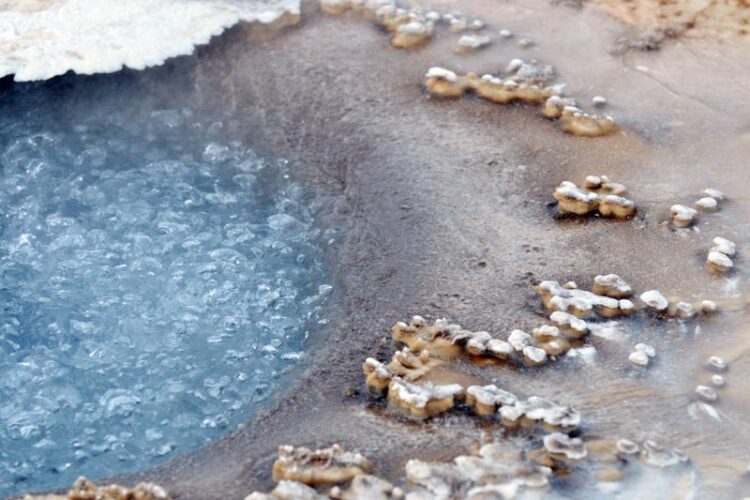Natural recycling at the origin of life

Volcanic freshwater lakes, similar to those found on Iceland today, offered a favorable niche on the early Earth. Low-salt, alkaline conditions enabled early RNA replication. | © Dieter Braun
A new study shows how the chemical properties of RNA molecules could have facilitated the emergence of complex life.
How was complex life able to develop on the inhospitable early Earth? At the beginning there must have been ribonucleic acid (RNA) to carry the first genetic information. To build up complexity in their sequences, these biomolecules need to release water. On the early Earth, which was largely covered in seawater, that was not so easy to do. In a paper recently published in the Journal of the American Chemical Society (JACS), researchers from the team of LMU professor Dieter Braun have shown that in RNA’s struggle with the surrounding water, its natural recycling capabilities and the right ambient conditions could have been decisive.
“The building blocks of RNA release a water molecule for every bond they form in a growing RNA chain,” explains Braun, spokesperson for the Collaborative Research Centre (CRC) Molecular Evolution in Prebiotic Environments and coordinator at the ORIGINS Excellence Cluster. “When, conversely, water is added to an RNA molecule, the RNA building blocks are fed back into the prebiotic pool.” This turnover of water works particularly well under low saline conditions with high pH levels. “Our experiments indicate that life could emerge from a very small set of molecules, under conditions such as those prevailing on volcanic islands on the early Earth,” says Adriana Serrão, lead author of the study.
Under these conditions, RNA has the ability to split without adding a water molecule. The end of the RNA strand remains water-free and can spontaneously re-form new RNA bonds. Braun’s laboratory demonstrated that the rebinding of this split RNA works efficiently and with remarkable precision when copying the sequence information. This process only takes place when the RNA building blocks are bound to a template RNA molecule with precisely matching base pairs in a double-stranded configuration. This produces a copy of the existing RNA strand before it disintegrates through the addition of water.
It had previously been assumed that RNA can only copy itself by ‘randomly’ constructing sequences of around 200 nucleotides in length – so-called ribozymes. However, ribozymes can operate only in saline, and thus RNA-hostile, environments. As a result of this new research, these complex ribozyme sequences in the early stages of RNA evolution are not necessary. “The precision is comparable to the copying of RNA achieved by ribozymes,” says Sreekar Wunnava, also lead author of the study. “This means that an RNA world could arise without the prior necessity for long complex sequences.”
Early life thus consisted of a very simple metabolic process whereby RNA sequences were copied by means of continuous replacement with recycled molecules. All that is needed for this to happen is an alkaline freshwater environment such as still exist today on volcanic islands like the Hawaiian archipelago or Iceland. “And so life could have emerged from a simple, cold prebiotic primordial soup of RNA building blocks,” explains Braun. Although the reactions take place very slowly under these conditions and require several days to complete, there was no shortage of time at the start of evolution and the cold freshwater refuges on primeval volcanic islands allowed RNA to survive on the otherwise inhospitable early Earth.
Journal: Journal of the American Chemical Society
DOI: 10.1021/jacs.3c10813
Method of Research: Experimental study
Subject of Research: Cells
Article Title: High-Fidelity RNA Copying via 2′,3′-Cyclic Phosphate Ligation
Article Publication Date: 19-Mar-2024
Media Contact
All latest news from the category: Life Sciences and Chemistry
Articles and reports from the Life Sciences and chemistry area deal with applied and basic research into modern biology, chemistry and human medicine.
Valuable information can be found on a range of life sciences fields including bacteriology, biochemistry, bionics, bioinformatics, biophysics, biotechnology, genetics, geobotany, human biology, marine biology, microbiology, molecular biology, cellular biology, zoology, bioinorganic chemistry, microchemistry and environmental chemistry.
Newest articles
Faster, more energy-efficient way to manufacture an industrially important chemical
Zirconium combined with silicon nitride enhances the conversion of propane — present in natural gas — needed to create in-demand plastic, polypropylene. Polypropylene is a common type of plastic found…

Energy planning in Ghana as a role model for the world
Improving the resilience of energy systems in the Global South. What criteria should we use to better plan for resilient energy systems? How do socio-economic, technical and climate change related…

Artificial blood vessels could improve heart bypass outcomes
Artificial blood vessels could improve heart bypass outcomes. 3D-printed blood vessels, which closely mimic the properties of human veins, could transform the treatment of cardiovascular diseases. Strong, flexible, gel-like tubes…




















